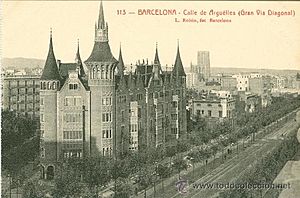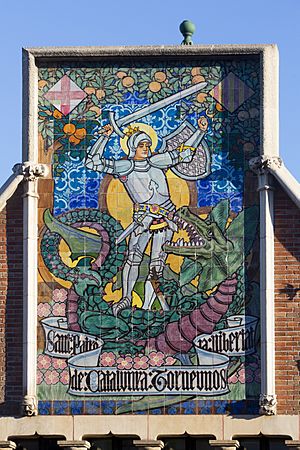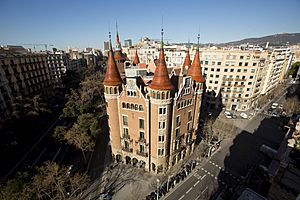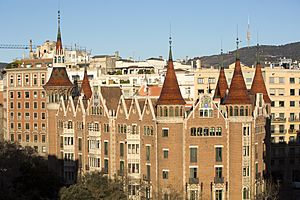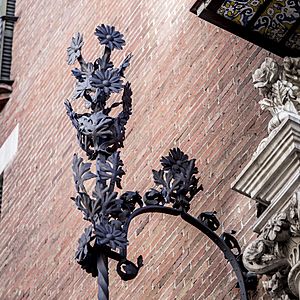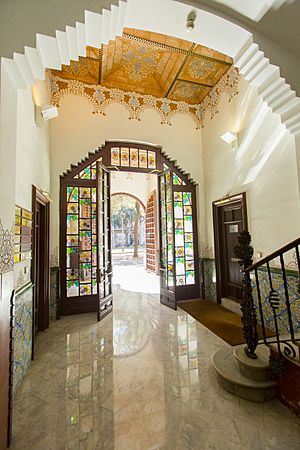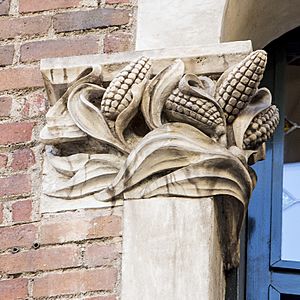Casa de les Punxes facts for kids
Quick facts for kids Casa de les Punxes |
|
|---|---|
|
La Casa de les Punxes
|
|
 |
|
| Alternative names | Casa Terradas |
| General information | |
| Type | Cultural Asset of National Interest 9 January 1976 RI-51-0004201 |
| Architectural style | Modernist |
| Location | Barcelona, Spain |
| Address | Avinguda Diagonal, 416–420 41°23'52.73"N, 2°9'49.62"E |
| Town or city | Barcelona, Catalonia |
| Country | Spain |
| Construction started | 1905 |
| Owner | Privately owned |
| Technical details | |
| Material | Stone, forge and stained glass work |
| Design and construction | |
| Architect | Josep Puig i Cadafalch |
The Casa de les Punxes or Casa Terradas is a famous building in Barcelona, Spain. It was designed by the amazing Modernist architect Josep Puig i Cadafalch. You can find it where three streets meet: Rosselló, Bruc, and Avinguda Diagonal.
In 1905, a man named Bartomeu Terradas Brutau asked Puig i Cadafalch to design a house. But it wasn't just one house! It was actually three houses, one for each of his sisters: Angela, Josefa, and Rosa. The architect made them look like one big, grand building.
The design reminds people of old medieval castles. It has six pointed towers, which look like spikes. This is why it got its popular name, "Casa de les Punxes," meaning "House of Spikes." This building is one of Barcelona's most important landmarks. It helps us understand the unique style of Catalan Modernism. In 1976, it was declared a historical monument. Today, it's privately owned and has offices inside. It's also a popular spot for tourists to visit.
Contents
History of the House
The Terradas Family
The story of Casa de les Punxes begins with the Terradas family. Bartomeu Terradas i Mont was a successful textile businessman. He had four children: Rosa, Bartomeu, Josefa, and Àngela. When he passed away, he left money to his three daughters and his wife.
His son, Bartomeu Terradas Brutau, used some of this money to build a special home for his sisters. He hired his friend, the architect Puig i Cadafalch, for the job. The architect wanted to give the houses a Central European feel.
In 1903, Puig i Cadafalch started designing the houses. The land was an unusual shape because of how the city of Barcelona was being planned. The architect decided to create one large building that looked like a medieval castle. It had six corners, fitting perfectly where the three streets met.
What the House Looks Like
The Outside (Façade)
The architect wanted the building to look like one big, impressive house. But if you look closely, you'll see special decorations. These details tell us about the three sisters who owned the houses.
- For Àngela Terradas: On the corner of Carrer Rosselló and Avinguda Diagonal, there's a beautiful stone carving. It shows an angel, which is a clear hint to Àngela's name. Around the main tower, you can also see the letters "ATB" repeated. These stand for Àngela Terradas Brutau.
- Flowers: You'll see many flower designs on the house. Clovers are a special choice, appearing in stone carvings and stained-glass windows.
- For Josefa Terradas: At number 418 Avinguda Diagonal, there's a ceramic panel. It's a sundial and a calendar all in one! It shows the four seasons with zodiac signs. A Latin phrase above it means, "Tomorrow will never fail you." This part of the house belonged to Josefa. You can also find her initial, "J," carved into some stone decorations.
- Saint George: On the back of Josefa's house, facing Carrer Rosselló, there's another ceramic panel. It shows Saint George fighting the dragon. Below this panel, you can see a sculpted face. It's the architect himself, Josep Puig i Cadafalch!
- For Rosa Terradas: On the Avinguda Diagonal and Carrer Bruc sides, there are two more ceramic panels. One has a vase of roses with the letters "RTB" (for Rosa Terradas Brutau). The other shows a girl surrounded by roses. This part of the house belonged to Rosa.
Hidden Meanings
The Casa Terradas is full of symbols. You can find them in the sculptures, ironwork, and glass. These symbols often have religious or mythological meanings. You'll see figures of men, some with horns, and sailor's knots. Plants are also very common, like apples, pomegranates, daisies, roses, and clovers.
New Ways to Build
Puig i Cadafalch was a very modern architect for his time. He changed how buildings were usually made. Instead of thick, load-bearing walls, he used cast iron pillars and metal beams on the ground floor. This made the spaces feel open and airy. It was a big step forward in building design!
After the Terradas Family
The three sisters who owned the houses didn't have children. So, when they passed away, the building went to their brother, Bartomeu Terradas Brutau.
In 1975, the building was recognized as a national historic monument. Over the years, it has gone through several restoration projects. These projects helped bring back its original beauty. Since July 2016, the house has been open for visitors.
Artists and Craftsmen
Many talented people worked on Casa Terradas.
Enric Monserdà (1850–1926)
Enric Monserdà was a very important artist for Casa Terradas. He helped design many of the decorative elements. This includes the stone carvings, the ceramic panels (like the Angel and Saint George), and the designs for the windows and ironwork. He also designed furniture and a small chapel inside the house.
Alfons Juyol i Bach (1860–1917)
Alfons Juyol was a sculptor who specialized in decorating buildings. He was very skilled and worked with many architects. He made sure every detail was perfect, even making small models before the final pieces were created.
Amigó Workshop
The Amigó workshop was the most important stained-glass studio in Barcelona. Ramon Eudald Amigó was a master at glass painting. For Casa Terradas, they created beautiful stained-glass windows for the entrance doors. These windows have plant designs with different colors and textures. They also helped filter the light, connecting the inside with the outside.
Manuel Ballarín i Lancuentra (1863–1915)
Manuel Ballarín was a leading artist in metal forging during the Modernist period. He worked with many famous Catalan architects. His company, Casa Ballarín, even started making machine-made metal parts. This made beautiful ironwork more affordable for everyone.
2016 Renovation
In 2016, the Casa de les Punxes went through a big renovation. Architect Jaume Falguera led this project. His goal was to bring back the original look and feel of Puig i Cadafalch's design.
Inside the Building
On the ground floor, old walls and ceilings were removed. This showed off the original columns that Puig i Cadafalch had used. These columns were a huge innovation at the time. They allowed for open, flexible spaces, which was very modern.
The renovation also added a new elevator. This makes it easier to get to the main floor and the rooftop. The main floors of the three buildings were originally apartments for the sisters. The renovation connected some of these rooms, creating a better flow.
The Rooftop
The roof is where you'll find the six famous pointed towers that give the house its name. It's a large, open space with amazing views of the city.
The biggest tower, on the corner of Avinguda Diagonal and Carrer Rosselló, has three levels. It shows off a clever building technique. The floors don't just sit on vertical supports. Instead, they hang from steel straps! This was a very advanced way to build and made the circular walls work differently. It's a great example of how innovative Puig i Cadafalch was.
See also
 In Spanish: Casa de les Punxes para niños
In Spanish: Casa de les Punxes para niños
- List of Modernisme buildings in Barcelona


